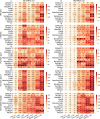Benchmarking metagenomic binning tools on real datasets across sequencing platforms and binning modes
- PMID: 40128535
- PMCID: PMC11933696
- DOI: 10.1038/s41467-025-57957-6
Benchmarking metagenomic binning tools on real datasets across sequencing platforms and binning modes
Abstract
Metagenomic binning is a culture-free approach that facilitates the recovery of metagenome-assembled genomes by grouping genomic fragments. However, there remains a lack of a comprehensive benchmark to evaluate the performance of metagenomic binning tools across various combinations of data types and binning modes. In this study, we benchmark 13 metagenomic binning tools using short-read, long-read, and hybrid data under co-assembly, single-sample, and multi-sample binning, respectively. The benchmark results demonstrate that multi-sample binning exhibits optimal performance across short-read, long-read, and hybrid data. Moreover, multi-sample binning outperforms other binning modes in identifying potential antibiotic resistance gene hosts and near-complete strains containing potential biosynthetic gene clusters across diverse data types. This study also recommends three efficient binners across all data-binning combinations, as well as high-performance binners for each combination.
© 2025. The Author(s).
Conflict of interest statement
Competing interests: All authors declare no competing interests.
Figures




Similar articles
-
Evaluating metagenomics tools for genome binning with real metagenomic datasets and CAMI datasets.BMC Bioinformatics. 2020 Jul 28;21(1):334. doi: 10.1186/s12859-020-03667-3. BMC Bioinformatics. 2020. PMID: 32723290 Free PMC article.
-
Benchmarking genome assembly methods on metagenomic sequencing data.Brief Bioinform. 2023 Mar 19;24(2):bbad087. doi: 10.1093/bib/bbad087. Brief Bioinform. 2023. PMID: 36917471
-
Complementary insights into gut viral genomes: a comparative benchmark of short- and long-read metagenomes using diverse assemblers and binners.Microbiome. 2024 Dec 20;12(1):260. doi: 10.1186/s40168-024-01981-z. Microbiome. 2024. PMID: 39707560 Free PMC article.
-
Classification of metagenomic sequences: methods and challenges.Brief Bioinform. 2012 Nov;13(6):669-81. doi: 10.1093/bib/bbs054. Epub 2012 Sep 8. Brief Bioinform. 2012. PMID: 22962338 Review.
-
Recovering metagenome-assembled genomes from shotgun metagenomic sequencing data: Methods, applications, challenges, and opportunities.Microbiol Res. 2022 Jul;260:127023. doi: 10.1016/j.micres.2022.127023. Epub 2022 Apr 8. Microbiol Res. 2022. PMID: 35430490 Review.
References
-
- Jansson, J. K. Microorganisms, climate change, and the sustainable development goals: progress and challenges. Nat. Rev. Microbiol.21, 622–623 (2023). - PubMed
-
- Prosser, J. I. et al. The role of ecological theory in microbial ecology. Nat. Rev. Microbiol.5, 384–392 (2007). - PubMed
-
- Tringe, S. G. & Rubin, E. M. Metagenomics: DNA sequencing of environmental samples. Nat. Rev. Genet.6, 805–814 (2005). - PubMed
-
- Albertsen, M. Long-read metagenomics paves the way toward a complete microbial tree of life. Nat. Methods20, 30–31 (2023). - PubMed
MeSH terms
Grants and funding
LinkOut - more resources
Full Text Sources

